Pliocene volcanic activity of the Harrat Ash-Sham, South of Syria: geochemistry and petrogenesis
Subject Areas : MineralogySafwan Dawod 1 * , Ali Al-Mishwat 2 , Abdulkarim Al Abdalla 3
1 - Ministry of Petroleum, the General Establishment of Geology, Syria
2 - Department of Earth and Environmental Sciences, Kuwait University, Kuwait
3 - Department of Geology, Tishreen University, Syria
Keywords: basalt, volcanism, Pliocene, Harrat Ash-Sham,
Abstract :
The Cenozoic volcanic activity of the Harrat Ash Sham volcanic field in south of Syria is a part of the extensive magmatism that took place in the auxiliary extension faults along the Dead Sea Fault Zone from upper Eocene to Holocene. Pliocene volcanic rocks form an important part of igneous succession in Syrian Part of Harrat as Sham. These rocks vary from basalts flows to scoria. Pliocene basalts are divided into three primary petrographic groups: olivine basalt, olivine-pyroxene basalt and basanite. The three petro-types are alkaline and have similar compositional ranges of major and trace elements. Variations in the contents of major and minor elements in the Pliocene basaltic rocks are very slight. Such homogeneity in the chemical composition indicates to the operation of petrological processes that reinforced each other during the genesis of these rocks. The geochemical characteristics of the Pliocene basalt rocks reflect crystallization from primitive basic magmas that have experienced limited crystal fractionation process subsequent to their derivation by partial melting of the upper mantle.

